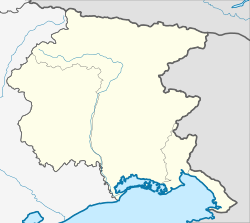Grado | |
|---|---|
| Comune di Grado | |
 | |
| Coordinates: 45°40′40″N 13°23′41″E / 45.677778°N 13.394722°E | |
| Country | Italy |
| Region | Friuli-Venezia Giulia |
| Province | Gorizia (GO) |
| Frazioni | Boscat, Fossalon, Pineta, Primero, Val Cavarera |
| Government | |
| • Mayor | Claudio Kovatsch |
| Area | |
| • Total | 114 km2 (44 sq mi) |
| Elevation | 2 m (7 ft) |
| Population (31-12-2019)[2] | |
| • Total | 8,064 |
| • Density | 71/km2 (180/sq mi) |
| Demonym | Gradesi |
| Time zone | UTC+1 (CET) |
| • Summer (DST) | UTC+2 (CEST) |
| Postal code | 34073 |
| Dialing code | 0431 |
| ISTAT code | 031009 |
| Patron saint | St. Hermagoras and Fortunatus |
| Saint day | July 12 |
| Website | Official website |
Grado (Venetian: Gravo; Friulian: Grau; Slovene: Gradež; Latin: Gradus[3]) is a town and comune (municipality) of 8,064 residents[4] in the Regional decentralization entity of Gorizia in the north-eastern Italian region of Friuli-Venezia Giulia, located on an island and adjacent peninsula of the Adriatic Sea between Venice and Trieste. The territory of the municipality of Grado extends between the mouth of the Isonzo and the Adriatic Sea and the Grado Lagoon, and covers an area of about 90 square kilometers between Porto Buso and Fossalon.[5] Characteristic of the lagoon is the presence of the casoni, which are simple houses with thatched roof used in the past by the fishermen of Grado, who remained in the lagoon for a long time, returning to the island of Grado only during the colder period of the year. [6]
Once mainly a fishing centre, today it is a popular tourist destination, known commonly as L'Isola del Sole ("The Island of the Sun"). It is also famous because it is a spa town; from 1873 a maritime hospice for children called Ospizio Marino wanted by the doctor Giuseppe Barellai was established on the island, because the climate and the environment of the island are a good place for the treatment of some childhood diseases. Subsequently, Grado was the chosen destination for marine thermal treatments, especially by the Austrian population.[7] Together with Marano Lagunare, it is the centre of the Marano-Grado Lagoon, which is famous for its uncontaminated nature. Grado is the birthplace of Biagio Marin, a poet who sang about the island in the local Venetian dialect.
- ^ "Superficie di Comuni Province e Regioni italiane al 9 ottobre 2011". Italian National Institute of Statistics. Retrieved 16 March 2019.
- ^ "Popolazione Residente al 1° Gennaio 2018". Italian National Institute of Statistics. Retrieved 16 March 2019.
- ^ Richard J.A. Talbert, ed. (2000). Barrington Atlas of the Greek and Roman World: Map-By-Map Directory. Vol. I. Princeton, NJ and Oxford, UK: Princeton University Press. p. 276. ISBN 0691049459.
- ^ "Statistiche demografiche ISTAT". demo.istat.it. Retrieved 2020-12-23.
- ^ Ezio Marocco. Bruno Fachin Editore (ed.). Grado: guida storico artistica. Trieste. p. 54.
- ^ Benedetti, Graziano (1994). Lagune del Friuli-Venezia Giulia: itinerari, tradizioni e antichi sapori. Alla scoperta di una natura affascinante. MAGNUS in LEGUIDE MAGNUS. p. 115.
- ^ Touring Club Italiano (2009). Gorizia e provincia: Il Collio, la valle dell'Isonzo, Grado e la laguna, il Carso. p. 97.



